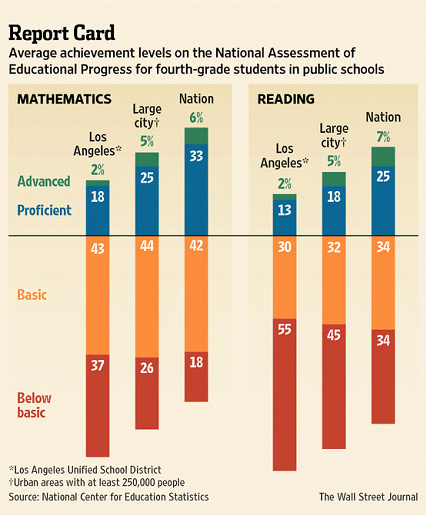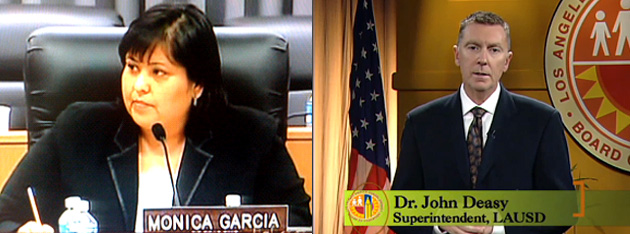Back to School in Los Angeles
Mary Morrison, American Renaissance, October 5, 2012
The Los Angeles Unified School District (LAUSD) fall session started early this year — three weeks early — in mid-August when temperatures in Los Angeles, especially the San Fernando Valley, regularly top triple digits. This “early start” was shoved through last spring without input from teachers or parents by the LAUSD Board of Trustees in their plush, air conditioned offices, far away from burning school blacktops, outdoor lunch areas with metal tables and benches, and roasting PE fields.
As could have been expected, a heat advisory was issued for the first week of school, with temperatures topping 104 in parts of the district. Students had to stay indoors, which meant they were stuck in classrooms or had to be herded into multi-purpose rooms for recess, PE, and lunch. There were no outdoor activities or sports, such as football and cross-country.
The school district is broke, but as the Los Angeles Daily News reported:
Los Angeles unified maintenance crews racked up more than $400,000 in overtime repairing overloaded air-conditioning units during the heat wave that swamped the region during the opening days of school, officials said.
Just about everything the district does is supposed to help close the racial achievement gap (see an account of some of the foolishness that has been devoted to this impossible goal here). This new “early start” program, we teachers are told, will help. It will improve test scores, “contribute to significant academic progress,” and better align public schools with college and university schedules. Of course.
As you can see from the chart below, our NAEP scores are way behind the rest of the country, and pretty near the bottom even for urban districts. It doesn’t exactly help that the district is 73.4 percent Hispanic and 10.2 percent black.
Along with “early start” we teachers were greeted with a 26-page letter from LAUSD’s $275,000-a-year superintendent, John Deasy and Board President Monica Garcia unveiling yet another new, strategic plan that will “transform human capital,” using a “theory of change” that will collect and analyze “robust data” to evaluate its effectiveness. The plan promises to use “teaching and learning foci” and “radically change the way teachers teach and students learn,” and make all students, upon graduation, “100 percent ready to enroll directly into a credit-bearing, academic college or work-force, career-ready, training.”
This latest scheme to “radically change the way teachers teach and students learn” goes by the name of Common Core State Standards (CCSS), a nation-wide, one-size-fits-all-plan that mandates, hilariously, that “students learn basic algebra and geometry skills while still in kindergarten.” Students will also write “increasingly complex essays” that will be “machine readable,” and “taken and scored” by computers that are “quite comparable to human consistency (sic).” All this according to Jose Ortega, administrator of the Education Technology Office for the California Department of Education. I’m not sure how all the testing and scoring will be done by computer since, according to LAUSD’s own records, 136 schools in the district still cannot connect to the Internet.
The LAUSD has tapped its new, $250,000-a-year deputy superintendent Jaime Aquino — from the Dominican Republic, no less — to engineer and implement the Common Core State Standards Plan. As he explains: “We’re going to expect the same out of every student,” meaning that all students — including those in Special Ed classes — are supposed to perform at the same level.
No doubt he thinks that with the right training, all students will write in the style of this sentence from the CCSS manual:
To be ready for college, workforce training, and life in a technological society, students need the ability to gather, comprehend, evaluate, synthesize, and report on information and ideas, to conduct original research in order to answer questions or solve problems, and to analyze and create a high volume and extensive range of print and nonprint texts in media forms old and new.
To demonstrate the “rigor” of CCSS to the public, the district has released a few sample questions of what will appear on the new CCSS Assessment Tests. Here is a selection from the 8th grade English Language section:
Local pride in the preservation of the cultural things that belong to the old days should be stimulated wherever possible, particularly in the minority groups. Remember that the Anglo-Saxon music which we are inclined to think of as the only “American” kind is a relatively recent importation on this continent, exactly as the Hungarian, Finnish and Armenian folk musics are. The Portuguese and Spanish have been in California three times as long as the “Americans.”
Why does the author write that the Portuguese and the Spanish have been in California longer than the “Americans?”
A to broaden the reader’s idea of what should be considered “American” folk music
B to argue that Hungarian, Finnish, and Armenian folk musics are not truly American
C to suggest that “American” folk music is music that has not been imported to the continent
D to convince the reader that the Portuguese and Spanish should not be considered minority groups in California.
Here is a selection from a 5th-grade reading called An American Hero: The Biography of César E. Chavez. Note that the passage uses the accented, Spanish spelling of the name, and refers to Chavez as “César.”
Life changed for César when he met a man named Fred Ross. Fred Ross believed that if people worked together they could make their community better. Fred Ross hired César to work for him in the Community Service Organization. The Community Service Organization worked to help people.
The companies and growers refused to treat the farm workers with respect and dignity. The growers did everything they could to stop César and the farm workers. They even turned to violence and hurt many farm workers and people who helped farm workers. This made César very upset.
César did not believe in violence. Like Martin Luther King, César wanted to bring change in a nonviolent way. Many people came to help César.
In my experience, example test questions released to the public are very different from the actual tests, which are much easier and even more PC. Reading material for actual tests is almost exclusively about blacks, Hispanics, the Holocaust, and, more recently, about Asians in America. Passages that explain how Asians were rounded up during the Second World War, incarcerated and mistreated by racist whites are especially popular.
The math portions of the real tests are also significantly easier than what the public sees as “released questions” in newspapers, practice books and homework assignments. This is one of the reasons the education system guards tests so carefully. I must sign affidavits stating that I will not photocopy or “share” the real test with anyone.
Teachers have a special motivation to support Common Core State Standards and make the program work: A recent court order requires that our teacher evaluations be tied to test scores. We will be graded by a complex formula, a “value added model,” that will combine test scores with demographic data to measure student progress to “gauge a teacher’s effectiveness in the classroom.” “The law is really clear,” says Superintendent Deasy, “and we need to move forward in creating an evaluation system that includes student progress.”
In other words, our performance will be evaluated by a formula, and we will be blamed if students fail to learn. At least the formula takes race into consideration, implicitly admitting that the district cannot expect the same results from all groups.
These fad programs are expensive. The Fordham Institute estimates that it will cost the state $380 million to $1.6 billion to inflict CCSS on us — despite continuing “severe” budget deficits. According to LAUSD’s own website, the district is in its fifth consecutive year of crisis. Our most recent $557 million shortfall resulted in layoffs for 5,000 employees and means there will be 10 teacher furlough days (unpaid vacation to cut costs) during the upcoming 2012-2013 school year.
For us teachers, CCSS is just one more in a long line of doomed programs the education system has tried and abandoned after two or three years of dismal results and frustrated students. Millions of dollars have been wasted on new textbooks and useless teacher training. We will keep trying programs like CCSS — and they will continue to fail — as long as schools continue to pretend there are no race differences in IQ.
We teachers know that when students fail to measure up to the “new” program’s unrealistic expectations we will be scapegoated publicly by the LAUSD administration, the local newspapers, and California’s state politicians. Only this time the ante has been raised because our job performance evaluations will be tied to the inevitable failure of CCSS. There are already calls in Sacramento to tie teacher pay directly to student test scores.
What no one likes to talk about is the fact that basing our evaluations and possibly our pay on test scores is the clearest possible invitation to cheat. AmRen reported recently that school districts across the country are reporting sudden improvements — and sudden drops — in test scores that can only be the result of cooking the scores. Does anyone think that LAUSD with its heavily Hispanic teachers and staff is immune to temptation?
Why anyone would want choose a career as a teacher in this age of insanity is beyond me.

















